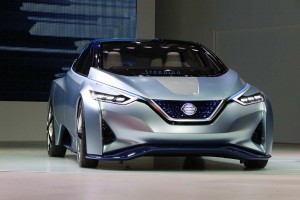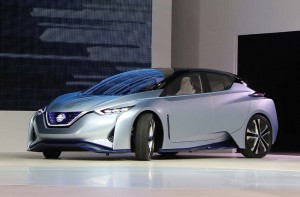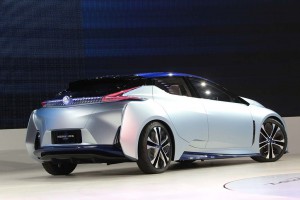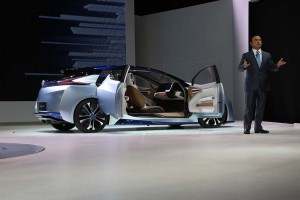Nissan has set out some aggressive goals for itself. It was the first major automaker to launch a battery-car, the Leaf, and it hopes to be the first to put an autonomous vehicle into high-volume production. The show car making its debut at this year’s Tokyo Motor Show is meant to show off the clean, safe technology the Japanese maker plans to deliver.
The low, sleek design of the IDS Concept – short for Intelligent Drive System – meanwhile, hints at the direction Nissan will take with the second-generation Leaf now under development, that battery-car expected to deliver more than twice the range of the Nissan Leaf currently on the road.
The IDS provides a vision of vehicles to come which will “revolutionize the relationship between car and driver,” said Nissan CEO Carlos Ghosn, during the official unveiling of the IDS.
After giving a handful of media outlets, including TheDetroitBureau.com, a drive in the latest autonomous Leaf prototype this week, Ghosn, during a separate conversation, said the company is on target. “We think we’re going to be ready by 2020 with autonomous city car.”

The low, sleek design of the IDS Concept hints at the design direction Nissan will take with the second-generation Leaf.
That very well could put it in a leadership position with the new technology. Japanese rival Honda, for example, has said it only expects to have a semi-autonomous system ready by decade’s end. Little Tesla this month began offering its new Autopilot system on the Model S sedan, but it is only capable of operating on limited access highways, and only then under optimum conditions.
Nissan will do things in stages, starting with what it calls its “Piloted Drive 1.0” technology in 2016.
“Piloted Drive 1.0 allows for safe autonomous driving under heavy highway traffic conditions,” the maker notes, adding that, “By 2018, the company hopes to implement a multiple lane autonomous drive system that can conduct lane changes on highways.”
By 2020, the goal is to make the so-called “Nissan Intelligent Driving” system capable of handling urban roads, as well.
The IDS hints at how Nissan will handle autonomous driving. The concept vehicle features two modes: one simple assists the driver, the other mode takes complete control.

Mazda's IDS concept vehicle features two modes: one simple assists the driver, the other mode takes complete control.
(Navigating Tokyo’s streets in Nissan’s autonomous Leaf. For more, Click Here.)
“That compensates for human error, which causes 90% of all accidents,” proclaimed Ghosn.
Two new technologies are in use on the IDS, including what Nissan claims to be “the world’s most advanced miniature, high-spec laser scanner,” and an eight-way camera system that gives the Intelligent Drive system a 360-degree view of the road.
A look at the concept vehicle reveals how quickly the technology is advancing. The original autonomous Leaf prototype was an ungainly affair, with slits cut into the body for LIDAR – 3D laser – sensors, and domes and cameras poking out all over. The latest Leaf prototype uses far less obtrusive sensors, and the concept vehicle suggests that they’ll be all but gone from view by the time the first fully autonomous Nissan vehicle hits the road.
“We at Nissan are setting clear goals and preparing for the implementation of autonomous drive. The prototype that we’re introducing here today is proof of how close we are towards the realization of this goal. Nissan aspires for a safe and trouble-free motoring future, and we plan on leading the industry in the implementation of autonomous drive,” said Nissan Senior Vice President of Nissan Takao Asami.

Two new technologies are in use on the IDS: an advanced miniature, high-spec laser scanner, and an eight-way camera system.
(To connect or not to connect? Federal officials debate the safety and privacy of connected car technology. Click Here for more.)
The IDS goes a step beyond simply taking over driving duties. It also uses a prototype system that will eventually have the ability to “learn and adapt to the behavior of the driver,” explained Ghosn. That could allow it to advise when a rest break is due – or even make suggestions on where to find a favorite type of food based on where the driver has stopped in the past.
The Intelligent Drive system is just one element of the technology inside the autonomous prototype. It also features a more advanced version of the Leaf’s electric drive system. Though details are scarce, that appears to mean both a modest increase in performance and a significant improvement in range.
With a 60-kWh battery, it would be able to deliver well over 200 miles of range, or more than twice what the 2016 Nissan Leaf can manage between charges.
As for the slick design of the Nissan autonomous concept vehicle. The maker’s global design director Shiro Nakamura tells TheDetroitBureau.com that it is a show car only. Unlike some of the other vehicles coming to this year’s Tokyo Motor Show, it won’t reappear in production form.
(Honda hopes to have semi-autonomous system on sale by 2020. Click Here for the story.)
That said, the more elegant shape won’t vanish entirely. It hints at the form language of the next-gen Leaf, Nakamura promises

